Research Article - (2015) Volume 23, Issue 3
Lecturer, Department of Public Health, Manado State University, Indonesia
Moazzam Ali, MD, MSc, PhD
Epidemiologist, Area Manager for South East Asia & Western Pacific Region at World Health Organization, Geneva, Switzerland
Rintaro Mori, MD, PhD, MSc, FRCPCH
Director, Department of Health Policy, National Research Institute for Child Health and Development, Tokyo
John J Wantania, MD
Obstetrician/Gynecologist, Department of Obstetrics and Gynaecology, Faculty of Medicine, Sam Ratulangi University, Indonesia
Chushi Kuroiwa, MD, Ph.D
Physician, Yotsukaido Tokushukai Medical Center, Yotsukaido, Japan
Kenji Shibuya, MD, DrPH
Professor, Department of Global Health Policy, Graduate School of Medicine, The University of Tokyo, Japan
Background: In Indonesia where abortion is prohibited by law, many women often seek unsafe services that result in complications requiring post-abortion care (PAC). This study was design to identify the characteristics of patients who sought PAC and to explore the perceptions and preferences regarding facility selection.
Methods: This hospital-based cross-sectional study was conducted in 2008 at 13 hospitals in North Sulawesi province, Indonesia. In total, 153 women, aged 15-49 years and who had had a recent abortion related complication and sought PAC at hospital were participated in the study. Multivariate logistic regression analysis was performed to assess associations between the potential covariates and the decision of public or private hospital.
Results: After controlling for other variables, age over 35 years (AOR 17.1; p<0.01), monthly income less than US$2.80 a day (AOR 6.9; p<0.05), low economic status (AOR 4.2; p<0.01), and choose the facility because of the low medical expenses (AOR 6.4; p<0.05) were significantly associated with selection of public hospitals [68%(104/153)] for PAC. Patients who were given information about pregnancy complications (OR 3.4; p<0.001), wished to ask questions (OR 2.4; p<0.05), willingly to return to the same hospital for follow-up (OR 3.0; p<0.001), and will recommend others due to good attitude of providers (OR 2.7; p<0.001) and good management (OR 8.1; p<0.001) of private hospital reported to be satisfied with the services [32% (49/153)].
Conclusion: Poor PAC seekers generally prefer public hospitals for the free or low-cost services. However, some poor patients still obtained PAC in the private sector due to perceived betterquality services. Thus, it is important for the government to improve the quality and amount of PAC in the public sector
Post-abortion care, health facility selection, quality care, women`s preferences, Indonesia
Induced abortion is a major obstetric complication and among the leading causes of death among women of reproductive age in many developing countries.[1] The abortion rate (the number of abortions per 1,000 women between 15-44 years of age) remains high in Asia, it ranges from 24 (in Western Asia) to 39 (in South-eastern Asia), and in Africa, ranging from 22 (in Northern Africa) to 39 (in Eastern Africa).[2] Overall, most of all unsafe abortions were in developing countries where abortion is legally restricted or socially stigmatized.[2-7]
Post-abortion care (PAC) is a package of services for women who experience complications following spontaneous or induced abortion.[1,2,8] Global awareness and support for PAC as a reproductive health intervention grew as a result of the International Conference on Population and Development (ICPD) in 1994, which recommended that ready access to postabortion counselling, education, and family planning should be provided to help avoid repeated abortions.[7-9] The PAC programs including contraceptive counselling and services have proven effective in many countries for increasing the acceptance of contraceptive methods[2,10-12] and decreasing repeated unwanted pregnancies and abortions.[13] Unfortunately, whether PAC reduces maternal mortality and unsafe abortion morbidity at the population level has only been assessed in few countries, such as Ghana.[14] This lack of PAC assessment reflects the associated social and methodological challenges as well as the high costs of measuring changes in maternal mortality.
Recent studies found that public hospital services are particularly important for poor women, who may need access to free care.[15,16] However, previous studies reported that women do not receive adequate services at public hospitals that lack of adequate equipment,[16] have poor facilities and long waiting times for treatment.[17,18] One study conducted in Mexico found that despite many deficiencies in the quality of care provided at public hospitals, almost all women reported being satisfied or even very satisfied with their care.[19] On the other hand, little is known about PAC in the private sector. One study in India found that private hospitals tended to offer better PAC services than public institutions with better availability of equipment and instruments, and shorter waiting times.[20]
Indonesia is one of 69 countries where abortion is highly restricted by law, being allowed only to save a woman’s life based on medical indications of abortion and the procedure being performed by duly authorized and qualified health professionals.[21,22] The incidence of hospital-based postabortion treatment has been rising since the mid-1970s. The hospital-based approach accommodates both legal abortions for medical indications and complications of abortions. Therefore, complying abortions are performed only by obstetricians/ gynaecologists or other registered medical practitioners in hospitals, or other approved maternal clinics.[22]
It is estimated that about two million abortions occurred in Indonesia in 2000. The estimate translates to an annual rate of 37 abortions for every 1,000 women of reproductive age.[23] The national health policy and programs put more attention for reproductive and maternal health. These steps were taken partially as a response to Indonesia's persistently high maternal mortality rate of approximately 307 maternal deaths per 100,000 live births in 2002-2003, decreased at 228 per 100,000 live births in 2007 and surprisingly increased to 359 per 100,000 live births in 2012.[22,23] However, like other countries where abortion is restricted, little information is available in Indonesia due to the policy debate on the legalization of abortion and whether research on this issue could be used to influence the abortion policy decision.[24] The existing data was limited to describe information in the rising number of induced abortion, the contradictions and inconsistencies in abortion issues,[25] and where the abortions were take places unsafe.[26] Moreover, no officially reported data are available on quality care of hospital due to abortion. Furthermore, no study has examined the factors that affect hospital selection for PAC services. The aim of the present study was to define the characteristics of patients who sought PAC and the determinants of such choices. Secondly, it aimed to explore their perceptions of and preferences for their chosen health facilities.
This cross-sectional study was carried out from January to March 2008 in North Sulawesi Province in Eastern Indonesia. Generally, this province has 14 district hospitals and 1 university teaching hospital owned and funded by the Ministry of Health or the local government, and 13 private hospitals funded by nongovernmental organizations. Of this, 12 hospitals comprising 6 public and 6 private hospitals were selected randomly and one teaching university hospital was also included based on the number of patients who sought care there for complications of abortions.
We included all patients of 15-49 years of age who presented with abortion-related complications as hospital admissions for PAC services who were available on the day when the interview was conducted and who agreed to participate. The symptoms and diagnoses of the complications of abortion were based on the patient medical records` lists in each hospital, such as bleeding, fever, abdominal pain and passage of soft tissues. Thus, women who had experienced spontaneous miscarriage or induced abortions without complication or women seeking PAC service outside of such facilities were excluded by this study.
A semi-structured questionnaire comprising multiplechoice questions was used to explore the characteristics or factors that influence a women’s decision to seek PAC services and her selection of healthcare facility. The questionnaire was developed based on the numerous vital information from some previous studies conducted in many countries. It covered sociodemographic characteristics, reproductive history including parity, gestational age and previous abortion, and a composite socioeconomic status indicator. The principal component analysis[27] was used to calculate factor scores for selected household assets, such as electricity, radio, television, mobile phone, telephone, watch, motorcycle, car, and refrigerator. The resulting asset scores were standardized to a normal distribution with a mean of zero and a standard deviation of one. A value of one was assigned to households that had a given asset and a value of zero to those without. The sum of these scores constituted the socioeconomic status index, which was then divided into low, medium, and high.
Information on abortion seeking was collected, including PAC-related health seeking behaviour. We also examined the following questions for association with patients` satisfaction with provider services to measure the quality of PAC services, such as if the health professional given any information needed, have wished to ask questions, will return for follow up and if they will recommend the PAC services to others.
The questionnaire was first developed in English, translated into Indonesian, and then back-translated. All interviews were conducted in the Indonesian language by trained interviewers who were working in the gynaecology department. The interviews were conducted in recovery room after patients received the PAC services. Each interview took approximately 45 minutes.
Construct and content validity test of the questionnaire was developed through systematic in-depth approaches with experts and conducted a pilot study. This feasibility study was done before the main phase of research to test the process of operationalizing and adequacy of the research tools and to train and familiarize research assistants with data collection techniques.
Institutional ethical approval was obtained from the ethics committees of the University of Tokyo and Provincial Health Office of North Sulawesi, Indonesia. Written informed consent was obtained from all participants before the interview. Patients were reassured that their names and information would remain confidential for study purposes. Data were kept confidential and the patients were identified by a study number.
Data were expressed as mean (standard deviation) and in order to find out the associations between various independent variables and perceptions on selection of facility, Pearson chi-square test and Fisher’s exact test were used by using the Statistical Package for Social Sciences (SPSS) version 13.0. Multivariate logistic regression analysis was performed for controlling the confounding variables in order to assess associations between the potential covariates and the patient’s decision of public or private hospital. A P value less than 0.05 was considered statistically significant.
Table 1 shows the characteristics of the respondents. The response rate in this study was 81%. The mean age was 30.6 years (±7.6). Among public hospital patients, one-third were in the second trimester of pregnancy, 39.2% (60/153) reported that the recent pregnancy was unwanted as they did not want a child soon, and 19.1% (29/153) had abortion experience before. Of the total study subjects, 28.1% (43/153) reported household incomes less than the National Standard Salary of Indonesia (US$85 a month).
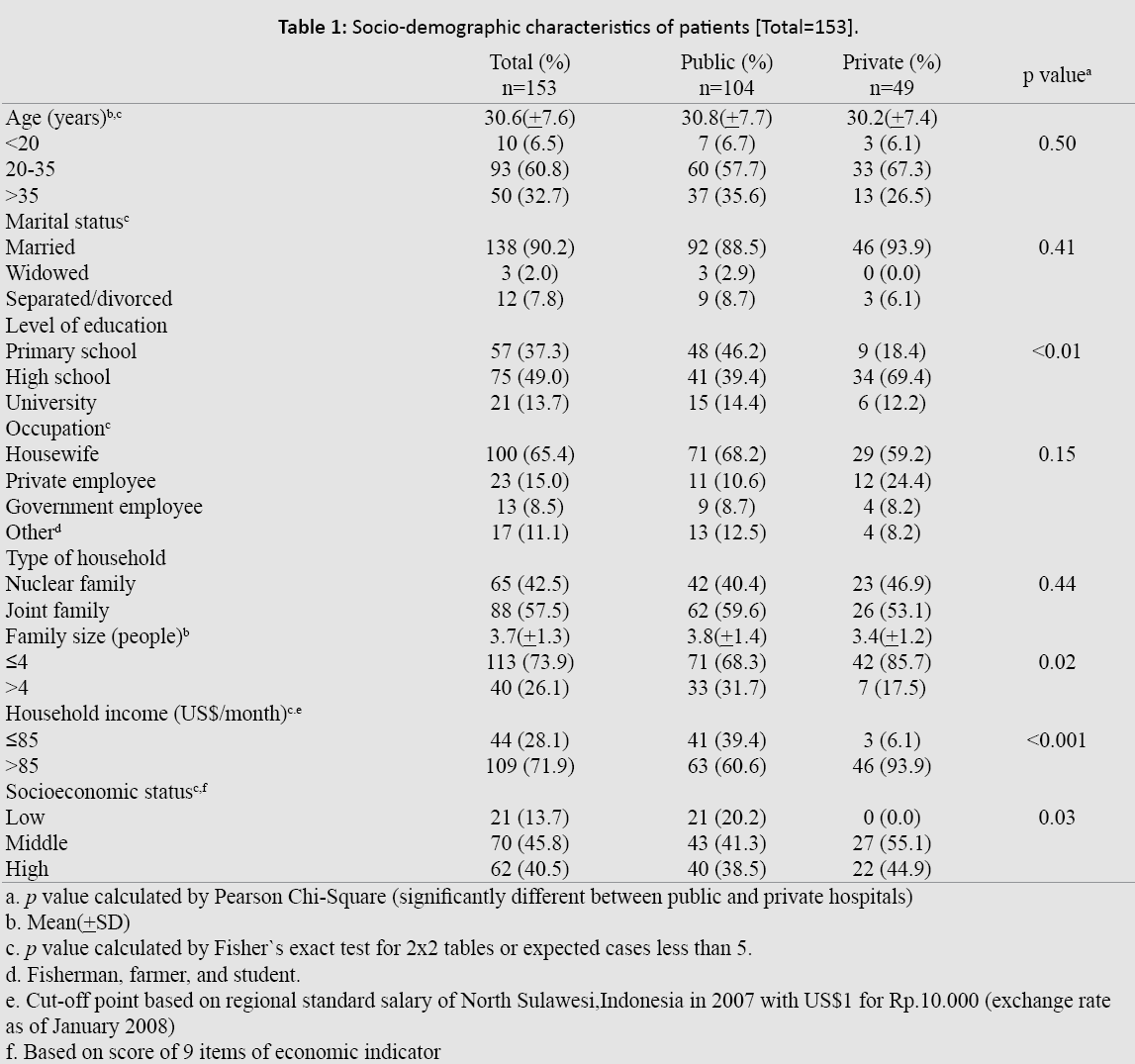
The husbands who were farmers (p=0.03), and had less education (p=0.05) were significantly more likely to take their wives to a public hospital (Table 2). Several questions specifically addressing the husband’s or significant other’s role in selection of PAC provider indicated that more than 90% (139/153) of women had discussed this topic with their husbands and these couples tended to select public hospitals [91.3%(95/104)].
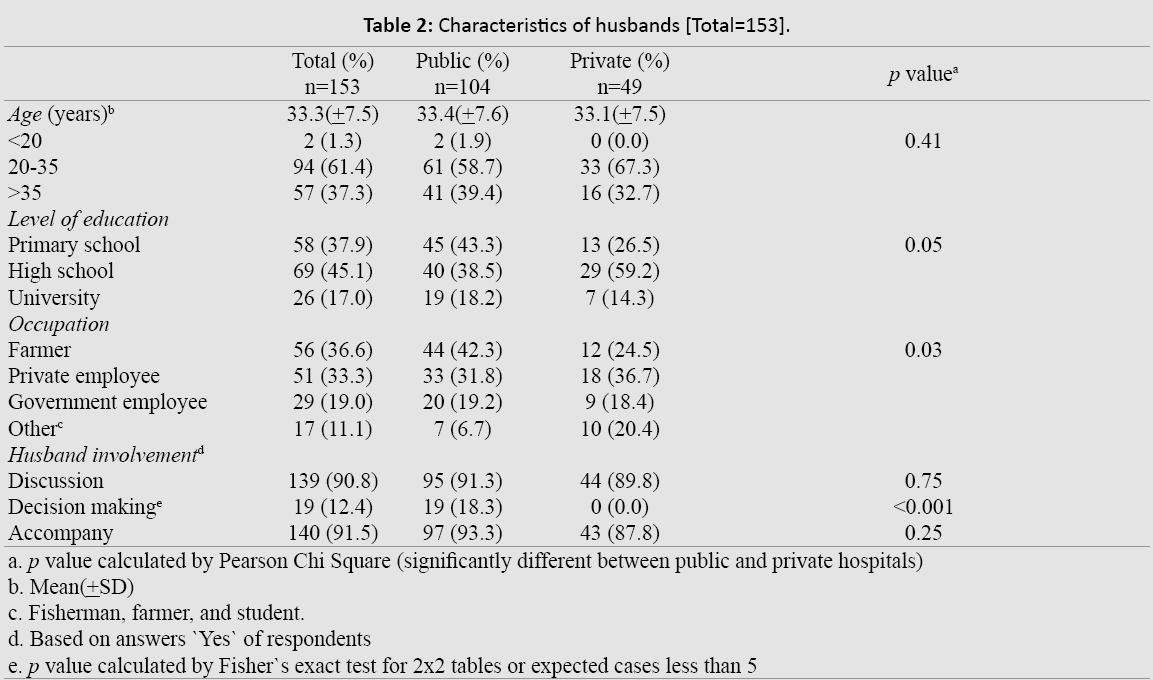
About 28.8% (44/153) of patients, particularly the poorest, preferred to go directly to public hospitals for performing abortions, as the services were free or the fees were the lowest. About 26.8% (41/153) of the patients preferred private hospitals, with 18.3% (28/153) preferring private clinics, 9.8% (15/153) preferring traditional birth attendants, and 16.3% (25/153) choosing other health facilities to seek abortions care. Women who had obtained their abortion in private clinics, traditional birth attendants or other health facilities, finally referred to whether public or private hospitals when the complications were occurred. The primary reason for attendance at public hospitals was the free or lower priced services [58.6% (61/104)]. On the other hand, those who chose private facilities cited proximity and adequate equipment as the major reasons [42.9% (21/49)].
Approximately 53.8% (56/104) of the patients who attended public hospitals reported waiting times of 2-5 hours until the procedure was underway, and 11.6% (12/104) waited more than 6 hours (Table 3). Only 32.7% (50/153) of the patients reported full satisfaction with the services they received (Table 4).
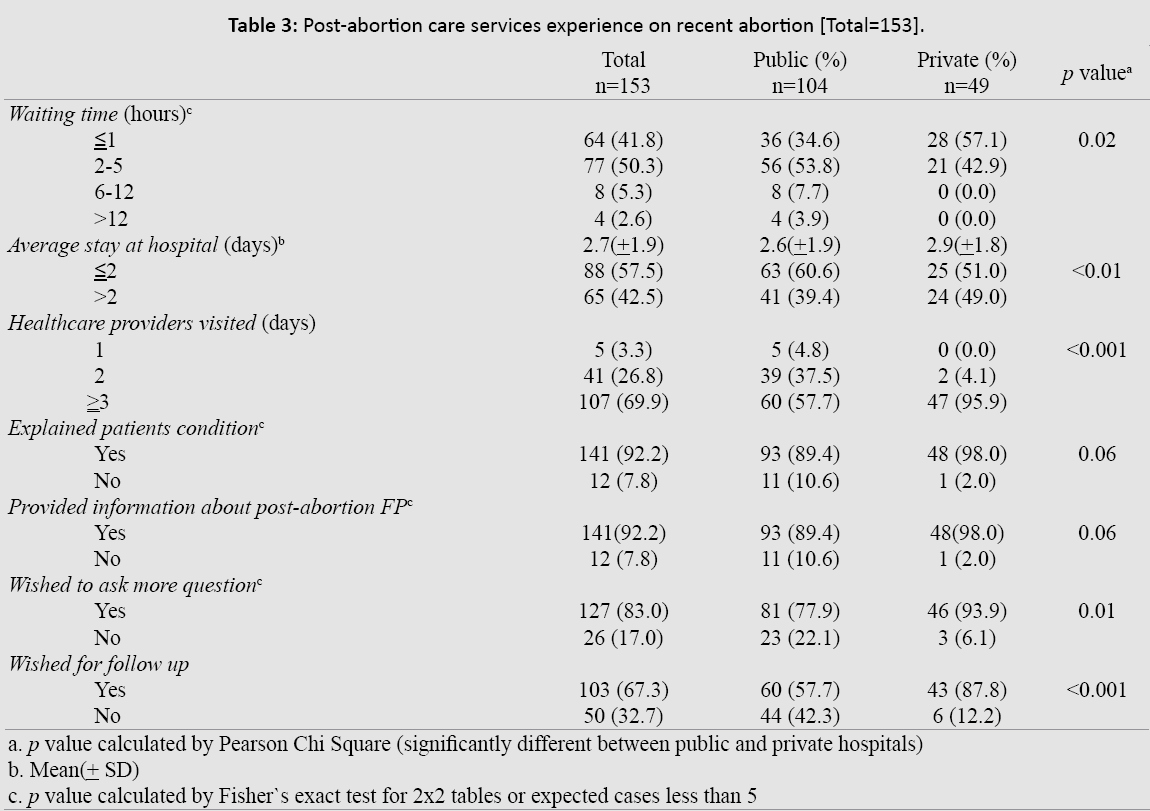
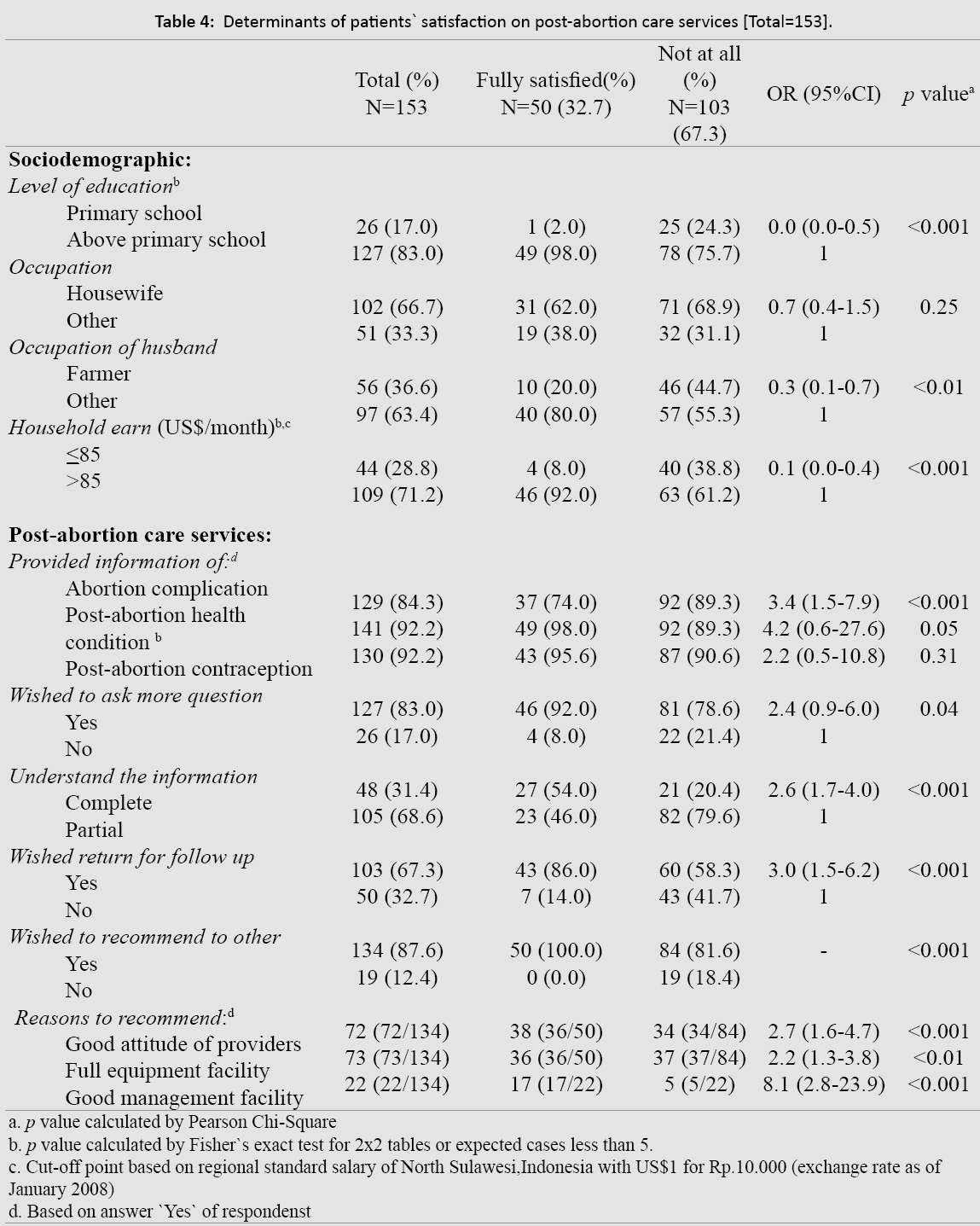
Table 5 shows the results of a multivariate logistic regression analysis of the choice of health facility. After controlling for selected predictors such as age, marital status, education, occupation, husband`s age, husband’s education, husband’s occupation, having child, having previous abortion, having experience of pregnancy, duration of pregnancy, household earnings, socioeconomic status and the reason on selection facility, the following parameters were significantly associated with the choice of public hospitals for PAC: age over 35 years (adjusted odds ratio (AOR) 17.1; 95%CI 1.8-161.7; p<0.01), monthly income less than US$85 (US$2.8 a day) (AOR 6.9, 95%CI 1.3-37.4; p<0.05), low economic status (AOR 4.2; 95%CI 1.2-15.2; p<0.01) and because of the low price or even free of PAC services (AOR 6.4, 95%CI 1.4-29.6; p<0.05).
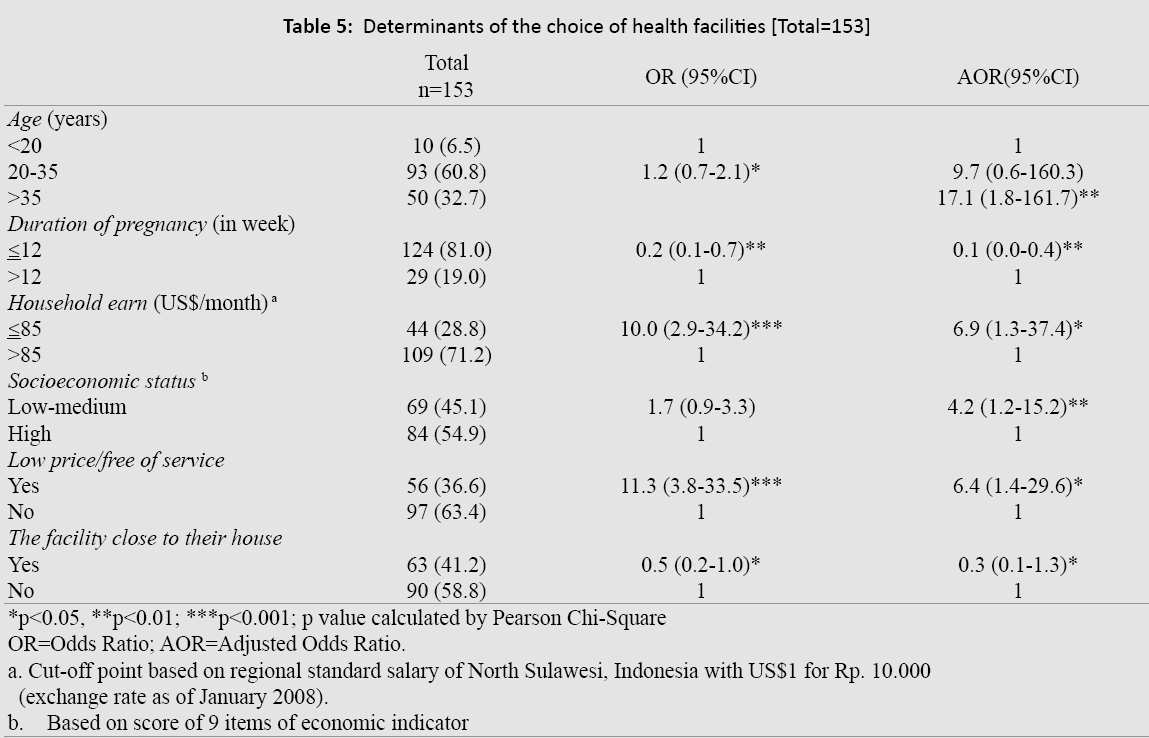
This was an exploratory study and the first in Indonesia to gather information on the highly sensitive topic of abortion, particularly presents patients perceptions and preferences regarding facility selection for PAC services. Since the induced abortion is highly prohibited by law and that the conditions under which abortion takes place are often unsafe, many abortions result in complications requiring PAC. Where do patients go and why do they go there for PAC services? Although this study does not show a full abortion situation in Indonesia, the evidence suggests that public hospitals were preferred by poorer care seekers. Patients in Indonesia who present to public hospitals with complications of spontaneous or induced abortion were older than patients in private hospitals, predominantly married and had more children. Patients who selected public hospitals were generally housewives and their partners were farmers. Their occupations reflected their income and socioeconomic status. This study also concurred that the majority of women who induce their own abortions by unskilled provider on request in second trimester of gestation and present with abortions complication in public hospitals were due to financial hardship.
The mean cost of treating incomplete abortion including hospitalization and transportation costs was US$12028 can depend on the provider; health facility and the method used a significant expense given that the participants average income was US$185 a month. In the Indonesian national health system, direct medicine expenses for PAC services for poor women are provided free of charge. The costs are covered by special government health insurance for poor people with monthly incomes less than US$85. Clearly, patients with lower income and lower socioeconomic status requiring free care or considerable use of low cost technology methods will go directly to public hospitals for PAC services.
This study also indicated that patients who attended public hospitals for abortion complications did not receive adequate PAC services since government facilities have not been able to develop the same level of service quality as private hospitals, such as long waiting times from arrival to treatment and poor in terms of inadequate provider-patient relations. Poor patients without access to safe abortion are more likely to turn to unsafe and unskilled providers and are consequently hospitalized more often for complications than higher-income patients. This problem is deeply rooted in culture, social beliefs, and a low awareness of client rights, even the right to ask questions. Although some of them willingness for continuing to go to public hospital could help to increase provider services and help fill in the gaps that exist.
Nonetheless, most patients of middle-level socioeconomic status continue to use the private sector for abortion, even when they must pay. Why do these patients continue to use private hospitals despite the considerably higher cost? Those patients in this study reported higher quality services in private hospitals in terms of medical abortion procedures, provide better information with respect to family planning, and minimal delays.
Finally yet importantly, in seeking assistance related to PAC services, the patients' first step was usually to discuss the problem with a trusted person. Most patients in this study reported consulting their partners before selection of the healthcare facility, as reported in a study from Australia.[29] The husband’s role was also central in the decision-making process and in encouraging the wife to seek PAC services. Overall, there was obvious interspousal communication about PAC services in Indonesia, and partners played an important role in hospital selection.
Our findings indicated that patients were quite satisfied with the services provided by private hospitals; they were willing to return for follow-up and cited their intention to recommend the services to others. In addition, the degree of satisfaction with private care facilities was not associated with the patient’s age, socioeconomic status, or educational level. These findings indicated that the perception of poor quality of care and services in public hospitals was a major reason for most patients to choose private hospitals if they could afford it.
This study had several limitations. First, as a cross-sectional study, it was not possible to infer a causal relationship between seeking post-abortion care or selection of healthcare facility and various independent variables. To understand the actual relationships underlying the selection of healthcare facility, prospective research is needed. Second, this study’s external validity is limited by the lack of patient representatives and might not be generalizable to the larger Indonesian population, as it was not random. However, this exploratory study is useful for describing patient perceptions on PAC services in Indonesia and awareness of public hospital PAC services may have changed. Therefore, studies which use random sampling techniques are useful regarding of the representative nature of the participants. Lastly, the study was based on patients’ self-reported recall of healthcare-seeking behaviours regarding abortion issues. Thus, it was difficult to establish whether participants were providing candid answers to the questions, particularly since the survey involved a sensitive matter. However, no inconsistencies were observed in the results.
This study finding suggested that poverty and economic distress contributed to the selection of public hospitals, especially among poor people, and well-equipped facilities and better healthcare provider services were the reason for selecting private hospitals. This study highlighted that different types of hospitals meet these needs in different ways. Overall, the quality of public hospitals` PAC services were found to be poor compared with private hospitals but public hospitals play an especially an important role in serving poor women. The deficiencies identified in this study should be used to develop evidence-based improvements to public hospitals’ capacity to strengthen public services in Indonesia, and particularly with regard to PAC services for complications including ensuring the availability of needed equipment and supplies to maximum standards of quality of care, accurate information on a range of family planning services and supplies, and better communication with patients. Implementation of women-centered PAC intervention could be one strategy to improve the situation. More women may gain access to qualified PAC facilities if public hospitals provide better-quality services. Access to PAC is a key aspect and placing it squarely on the agenda of health providers will increase access and quality of PAC services more than most any other strategy. Health provider knowledge and attitude or training interventions should be researched in order to assess information dissemination and patient compliance. Finally, a comprehensive approach should extend existing policies to offer effective PAC and improve service quality, safety, efficiency, and capacity.
We thank all patients and healthcare providers for their enthusiastic participation in this study. We are very grateful to Dr. Yoshihisa Shirayama and Christian Tilaar, MD, M.Sc, for their encouraging and continued support during the preparation of this paper.